An Amcan Travel
customer visit to the Orient, 2005.
The China itinerary can be found at
http://www.goamcan.com/travel/chinalifetime.html.
A Busy Trip to the Orient
The flight to Tokyo was uneventful except for my anxiety over the
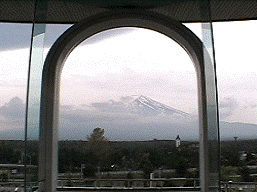 seventy-kilometer rail trip from the airport to Sunshine City on the
complex Tokyo rail system. But that turned out to be quite an easy
trip when we went down to the train station level, at the airport, and
immediately found an express train to Ikebukero Station, which is the
station closest to our hotel. In a couple hours we were comfortably
ensconced in our thirty fourth-floor hotel room, which had a grand
view over the city. We stayed five nights in Tokyo visiting such
places as the Imperial Palace grounds, the Ginza district. We took a
day trip to Mount Fuji by bus, which included an exotic lunch at a
hotel with a glorious view of the mountain from the dining room. For
the ride home we chose to ride the Bullet Train back to Tokyo.
seventy-kilometer rail trip from the airport to Sunshine City on the
complex Tokyo rail system. But that turned out to be quite an easy
trip when we went down to the train station level, at the airport, and
immediately found an express train to Ikebukero Station, which is the
station closest to our hotel. In a couple hours we were comfortably
ensconced in our thirty fourth-floor hotel room, which had a grand
view over the city. We stayed five nights in Tokyo visiting such
places as the Imperial Palace grounds, the Ginza district. We took a
day trip to Mount Fuji by bus, which included an exotic lunch at a
hotel with a glorious view of the mountain from the dining room. For
the ride home we chose to ride the Bullet Train back to Tokyo.
We flew to Beijing the next day where a very charming young lady guide
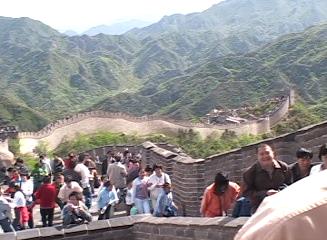 showed us around the usual tourist spots. It was a Chinese national
holiday and everywhere was crowded. The Great Wall in particular,
which was wall-to-wall people that made climbing the often steep steps
quite a challenge. We could see the wall stretching over the very
rugged mountains in three directions. The next day we drove to
Tiananmen Square, which was interesting to visit after all the news
footage seen on TV news. What surprised me most was the huge line to
view Mao Zhedong's tomb in a large mausoleum at Tiananmen Square.
showed us around the usual tourist spots. It was a Chinese national
holiday and everywhere was crowded. The Great Wall in particular,
which was wall-to-wall people that made climbing the often steep steps
quite a challenge. We could see the wall stretching over the very
rugged mountains in three directions. The next day we drove to
Tiananmen Square, which was interesting to visit after all the news
footage seen on TV news. What surprised me most was the huge line to
view Mao Zhedong's tomb in a large mausoleum at Tiananmen Square.
Unfortunately, my camcorder was stolen as we were leaving a crowded
"Temple of Heaven" and we spent several hours making out a police
report before flying on to Xi'an, where we were met by another
charming young guide.
The most important thing on my mind was to get a new camcorder, as I
didn't want to miss making my epic video of this trip of a lifetime.
At a large camera shop I chose another Canon that was similar in many
ways to the one I lost, except that all camcorders in China use the
PAL system, but I thought I would deal with that problem when I got
home.
At Xi'an, first day, we visited the famous Terra Cotta Warriors
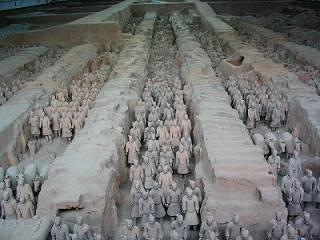 Museum, which was an extraordinary sight of thousands of life-size
warrior replicas that have been buried for centuries and only
discovered a few years ago. We were very fortunate that the museum
had lifted the ban on photography a couple of months earlier, so I was
able to get many good photographs of the warriors.
Museum, which was an extraordinary sight of thousands of life-size
warrior replicas that have been buried for centuries and only
discovered a few years ago. We were very fortunate that the museum
had lifted the ban on photography a couple of months earlier, so I was
able to get many good photographs of the warriors.
In the afternoon we drove to the Banpo Neolithic village and in the
evening attended a Tang Dynasty music and dance dinner show. This was
a really great evening, particularly as we had probably the best seats
in the house. The meal included eight courses and a bottle of wine.
The show was absolutely fabulous with musicians and very colorful
dancers. Next day we toured the ancient city wall, the Wild Goose
Pagoda and the Grand Mosque in the Muslim quarter.
The following day we flew to Lhasa, which is fourteen thousand feet
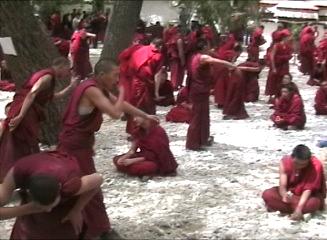 high in the mountains of Tibet where a very helpful male guide greeted
us. It was a seventy-kilometer drive to Lhasa through some very
beautiful mountain and river scenery. Our schedule said relax for the
rest of the day to adjust to the lack of oxygen at this high altitude.
I'm afraid it doesn't happen that quickly as we were still breathing
heavily when we left three days later. The main place to visit here is
the Potola Palace, where the Buddhist religion was first established
in this region. Outside, there was a large procession of worshippers
slowly walking around the palace while at the same time they were
praying. Some would lay prone on the ground during this time. The
palace had many dimly lit rooms and corridors with many golden statues
of various Buddhas, and hundreds of breathtaking (literally) steep
steps to negotiate. Visits were also made to a rug factory and a
temple where we witnessed a very interesting practice of the trainee
monks called "Debate". These trainees enter the monastery for a
period of twenty-two years before graduating as monks. Each
afternoon, after class, they meet in a courtyard and fire questions at
each other about the day's lesson and the answers are fired back in a
very animated fashion.
high in the mountains of Tibet where a very helpful male guide greeted
us. It was a seventy-kilometer drive to Lhasa through some very
beautiful mountain and river scenery. Our schedule said relax for the
rest of the day to adjust to the lack of oxygen at this high altitude.
I'm afraid it doesn't happen that quickly as we were still breathing
heavily when we left three days later. The main place to visit here is
the Potola Palace, where the Buddhist religion was first established
in this region. Outside, there was a large procession of worshippers
slowly walking around the palace while at the same time they were
praying. Some would lay prone on the ground during this time. The
palace had many dimly lit rooms and corridors with many golden statues
of various Buddhas, and hundreds of breathtaking (literally) steep
steps to negotiate. Visits were also made to a rug factory and a
temple where we witnessed a very interesting practice of the trainee
monks called "Debate". These trainees enter the monastery for a
period of twenty-two years before graduating as monks. Each
afternoon, after class, they meet in a courtyard and fire questions at
each other about the day's lesson and the answers are fired back in a
very animated fashion.
Our next flight took us to Chengdu where we were driven about one
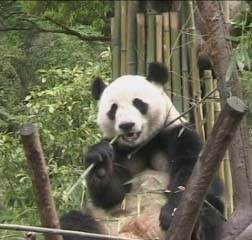 hundred kilometers to the Panda Reserve at Wolong. There they care
for about fifty percent of the world captive pandas. There are many
more wild ones in the surrounding steeply wooded valleys. The Giant
Panda is claimed to be the only mammal that survived the Ice Age and
is still alive today. However, it is on the brink of extinction due,
in part to the encroachment of mankind, but also due to it's extreme
laziness. The keepers have to shut them out of the stone buildings
where they sleep in order to make them eat. And would you believe
that they are also too lazy to mate! The females frequently have to
be artificially inseminated in order to produce young.
hundred kilometers to the Panda Reserve at Wolong. There they care
for about fifty percent of the world captive pandas. There are many
more wild ones in the surrounding steeply wooded valleys. The Giant
Panda is claimed to be the only mammal that survived the Ice Age and
is still alive today. However, it is on the brink of extinction due,
in part to the encroachment of mankind, but also due to it's extreme
laziness. The keepers have to shut them out of the stone buildings
where they sleep in order to make them eat. And would you believe
that they are also too lazy to mate! The females frequently have to
be artificially inseminated in order to produce young.
Back in Chengdu we were shown around the cottage of the great Tang
Dynasty poet Du Fu and also visited cultural park before a bus ride to
Chongking on the Yangtze River, where we boarded the M/V Victoria for
a three-day cruise and a well deserved rest for our weary bones.
We sailed through the famous Three Gorges that are gradually being
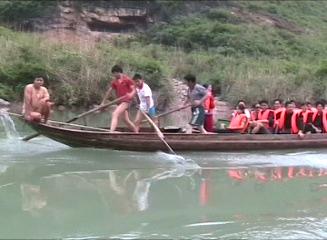 flooded after the construction of the Gezhou Dam. On the second day
all the passengers boarded a smaller ferry boat for a trip along a
narrow tributary with steep cliffs along each bank. Further along we
came to a small dock area where we all transferred to six sampans.
These had a strange arrangement with three oarsmen at the front, and
one at the back. These oarsmen stood and pushed on the oars to propel
us along. In the past they used to do this in the nude, but some
ladies objected to this, so now they wear shorts. Further along the
stony bottom became too shallow for rowing and they resorted to
pulling the sampans by means of long ropes. Eventually the river
became too shallow for even this and we turned around and went back to
the dock where the ferry was waiting to take us back to the
cruise-ship. A very interesting little side trip.
flooded after the construction of the Gezhou Dam. On the second day
all the passengers boarded a smaller ferry boat for a trip along a
narrow tributary with steep cliffs along each bank. Further along we
came to a small dock area where we all transferred to six sampans.
These had a strange arrangement with three oarsmen at the front, and
one at the back. These oarsmen stood and pushed on the oars to propel
us along. In the past they used to do this in the nude, but some
ladies objected to this, so now they wear shorts. Further along the
stony bottom became too shallow for rowing and they resorted to
pulling the sampans by means of long ropes. Eventually the river
became too shallow for even this and we turned around and went back to
the dock where the ferry was waiting to take us back to the
cruise-ship. A very interesting little side trip.
We spent the last night on the boat working our way through the huge
 five-chambered ship lock, which lowered us nearly one hundred meters
(over one hundred feet) to the Lower Yangtze River. This last night
was also memorable to me as it was my birthday and at dinner a
birthday cake was put on every table, and everybody in the dining room
sang "Happy Birthday" to me. This was followed by a special rendition
in Chinese by Spring, which was the English name adopted by the
hardworking, and equally charming young lady guide for the voyage.
five-chambered ship lock, which lowered us nearly one hundred meters
(over one hundred feet) to the Lower Yangtze River. This last night
was also memorable to me as it was my birthday and at dinner a
birthday cake was put on every table, and everybody in the dining room
sang "Happy Birthday" to me. This was followed by a special rendition
in Chinese by Spring, which was the English name adopted by the
hardworking, and equally charming young lady guide for the voyage.
The next morning, after passing through another spectacular gorge we
were transferred to a private car and driven over one hundred
kilometers to our Holiday Inn Hotel in Wuhan in preparation for our
early morning flight to Shanghai next day. In the afternoon we were
escorted through the Yuyuan Garden and the Jade Buddha Temple.
Although not on our original itinerary, we managed to get the guide to
take us on the MagLev train to the airport and back, as I really
wanted to ride on this modern train, but it would not be running in
time for our trip to the airport next morning. This is the only
MagLev train in regular passenger use in the world, and reaches a
speed of four hundred and thirty KPH (270 MPH), on it's route to the
airport, Later in the day we walked along Nanjing Road, which is a
very busy shopping precinct and then on to the Bund waterfront
esplanade with it's panoramic view of the modern city buildings on the
opposite bank of the Yangtze River..
We were driven to the airport early the next morning and said goodbye
to a very memorable trip in China. Very soon we were on a flight
back to Tokyo. There we transferred to a flight for Los Angeles
where we arrived fifty minutes early thanks to a strong jet stream.
It was great to be back home after such a busy vacation and get back
into routine of life at home. But that won't last for long because
we already have several trips lined up for the future.
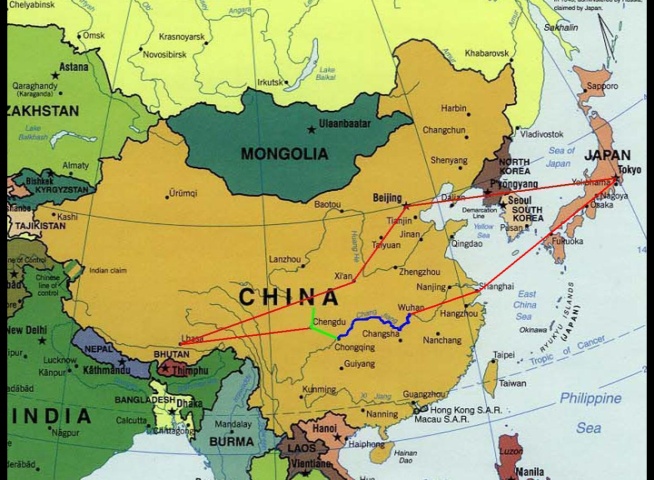
 seventy-kilometer rail trip from the airport to Sunshine City on the
complex Tokyo rail system. But that turned out to be quite an easy
trip when we went down to the train station level, at the airport, and
immediately found an express train to Ikebukero Station, which is the
station closest to our hotel. In a couple hours we were comfortably
ensconced in our thirty fourth-floor hotel room, which had a grand
view over the city. We stayed five nights in Tokyo visiting such
places as the Imperial Palace grounds, the Ginza district. We took a
day trip to Mount Fuji by bus, which included an exotic lunch at a
hotel with a glorious view of the mountain from the dining room. For
the ride home we chose to ride the Bullet Train back to Tokyo.
seventy-kilometer rail trip from the airport to Sunshine City on the
complex Tokyo rail system. But that turned out to be quite an easy
trip when we went down to the train station level, at the airport, and
immediately found an express train to Ikebukero Station, which is the
station closest to our hotel. In a couple hours we were comfortably
ensconced in our thirty fourth-floor hotel room, which had a grand
view over the city. We stayed five nights in Tokyo visiting such
places as the Imperial Palace grounds, the Ginza district. We took a
day trip to Mount Fuji by bus, which included an exotic lunch at a
hotel with a glorious view of the mountain from the dining room. For
the ride home we chose to ride the Bullet Train back to Tokyo.
 showed us around the usual tourist spots. It was a Chinese national
holiday and everywhere was crowded. The Great Wall in particular,
which was wall-to-wall people that made climbing the often steep steps
quite a challenge. We could see the wall stretching over the very
rugged mountains in three directions. The next day we drove to
Tiananmen Square, which was interesting to visit after all the news
footage seen on TV news. What surprised me most was the huge line to
view Mao Zhedong's tomb in a large mausoleum at Tiananmen Square.
showed us around the usual tourist spots. It was a Chinese national
holiday and everywhere was crowded. The Great Wall in particular,
which was wall-to-wall people that made climbing the often steep steps
quite a challenge. We could see the wall stretching over the very
rugged mountains in three directions. The next day we drove to
Tiananmen Square, which was interesting to visit after all the news
footage seen on TV news. What surprised me most was the huge line to
view Mao Zhedong's tomb in a large mausoleum at Tiananmen Square.
 Museum, which was an extraordinary sight of thousands of life-size
warrior replicas that have been buried for centuries and only
discovered a few years ago. We were very fortunate that the museum
had lifted the ban on photography a couple of months earlier, so I was
able to get many good photographs of the warriors.
Museum, which was an extraordinary sight of thousands of life-size
warrior replicas that have been buried for centuries and only
discovered a few years ago. We were very fortunate that the museum
had lifted the ban on photography a couple of months earlier, so I was
able to get many good photographs of the warriors.
 high in the mountains of Tibet where a very helpful male guide greeted
us. It was a seventy-kilometer drive to Lhasa through some very
beautiful mountain and river scenery. Our schedule said relax for the
rest of the day to adjust to the lack of oxygen at this high altitude.
I'm afraid it doesn't happen that quickly as we were still breathing
heavily when we left three days later. The main place to visit here is
the Potola Palace, where the Buddhist religion was first established
in this region. Outside, there was a large procession of worshippers
slowly walking around the palace while at the same time they were
praying. Some would lay prone on the ground during this time. The
palace had many dimly lit rooms and corridors with many golden statues
of various Buddhas, and hundreds of breathtaking (literally) steep
steps to negotiate. Visits were also made to a rug factory and a
temple where we witnessed a very interesting practice of the trainee
monks called "Debate". These trainees enter the monastery for a
period of twenty-two years before graduating as monks. Each
afternoon, after class, they meet in a courtyard and fire questions at
each other about the day's lesson and the answers are fired back in a
very animated fashion.
high in the mountains of Tibet where a very helpful male guide greeted
us. It was a seventy-kilometer drive to Lhasa through some very
beautiful mountain and river scenery. Our schedule said relax for the
rest of the day to adjust to the lack of oxygen at this high altitude.
I'm afraid it doesn't happen that quickly as we were still breathing
heavily when we left three days later. The main place to visit here is
the Potola Palace, where the Buddhist religion was first established
in this region. Outside, there was a large procession of worshippers
slowly walking around the palace while at the same time they were
praying. Some would lay prone on the ground during this time. The
palace had many dimly lit rooms and corridors with many golden statues
of various Buddhas, and hundreds of breathtaking (literally) steep
steps to negotiate. Visits were also made to a rug factory and a
temple where we witnessed a very interesting practice of the trainee
monks called "Debate". These trainees enter the monastery for a
period of twenty-two years before graduating as monks. Each
afternoon, after class, they meet in a courtyard and fire questions at
each other about the day's lesson and the answers are fired back in a
very animated fashion.
 hundred kilometers to the Panda Reserve at Wolong. There they care
for about fifty percent of the world captive pandas. There are many
more wild ones in the surrounding steeply wooded valleys. The Giant
Panda is claimed to be the only mammal that survived the Ice Age and
is still alive today. However, it is on the brink of extinction due,
in part to the encroachment of mankind, but also due to it's extreme
laziness. The keepers have to shut them out of the stone buildings
where they sleep in order to make them eat. And would you believe
that they are also too lazy to mate! The females frequently have to
be artificially inseminated in order to produce young.
hundred kilometers to the Panda Reserve at Wolong. There they care
for about fifty percent of the world captive pandas. There are many
more wild ones in the surrounding steeply wooded valleys. The Giant
Panda is claimed to be the only mammal that survived the Ice Age and
is still alive today. However, it is on the brink of extinction due,
in part to the encroachment of mankind, but also due to it's extreme
laziness. The keepers have to shut them out of the stone buildings
where they sleep in order to make them eat. And would you believe
that they are also too lazy to mate! The females frequently have to
be artificially inseminated in order to produce young.
 flooded after the construction of the Gezhou Dam. On the second day
all the passengers boarded a smaller ferry boat for a trip along a
narrow tributary with steep cliffs along each bank. Further along we
came to a small dock area where we all transferred to six sampans.
These had a strange arrangement with three oarsmen at the front, and
one at the back. These oarsmen stood and pushed on the oars to propel
us along. In the past they used to do this in the nude, but some
ladies objected to this, so now they wear shorts. Further along the
stony bottom became too shallow for rowing and they resorted to
pulling the sampans by means of long ropes. Eventually the river
became too shallow for even this and we turned around and went back to
the dock where the ferry was waiting to take us back to the
cruise-ship. A very interesting little side trip.
flooded after the construction of the Gezhou Dam. On the second day
all the passengers boarded a smaller ferry boat for a trip along a
narrow tributary with steep cliffs along each bank. Further along we
came to a small dock area where we all transferred to six sampans.
These had a strange arrangement with three oarsmen at the front, and
one at the back. These oarsmen stood and pushed on the oars to propel
us along. In the past they used to do this in the nude, but some
ladies objected to this, so now they wear shorts. Further along the
stony bottom became too shallow for rowing and they resorted to
pulling the sampans by means of long ropes. Eventually the river
became too shallow for even this and we turned around and went back to
the dock where the ferry was waiting to take us back to the
cruise-ship. A very interesting little side trip.
 five-chambered ship lock, which lowered us nearly one hundred meters
(over one hundred feet) to the Lower Yangtze River. This last night
was also memorable to me as it was my birthday and at dinner a
birthday cake was put on every table, and everybody in the dining room
sang "Happy Birthday" to me. This was followed by a special rendition
in Chinese by Spring, which was the English name adopted by the
hardworking, and equally charming young lady guide for the voyage.
five-chambered ship lock, which lowered us nearly one hundred meters
(over one hundred feet) to the Lower Yangtze River. This last night
was also memorable to me as it was my birthday and at dinner a
birthday cake was put on every table, and everybody in the dining room
sang "Happy Birthday" to me. This was followed by a special rendition
in Chinese by Spring, which was the English name adopted by the
hardworking, and equally charming young lady guide for the voyage.
